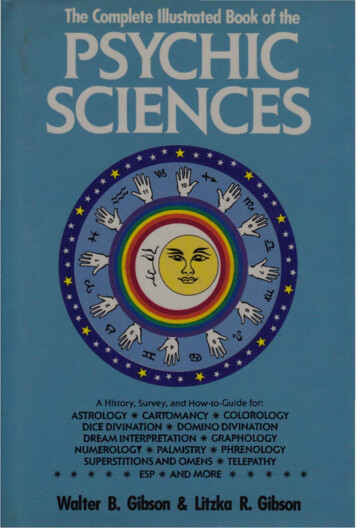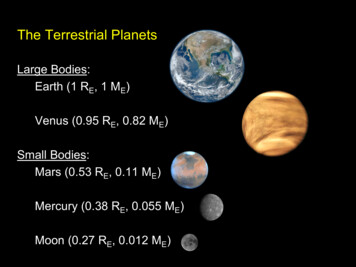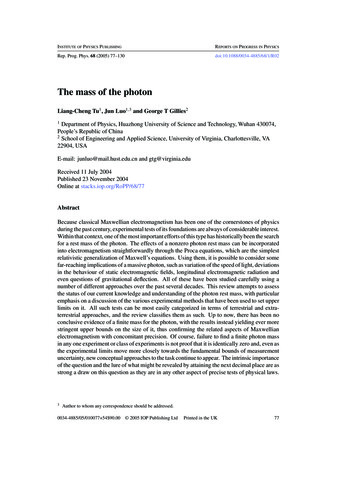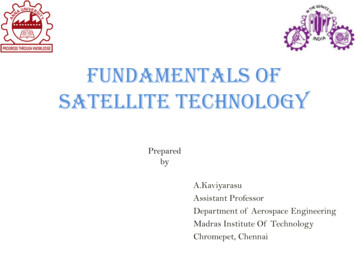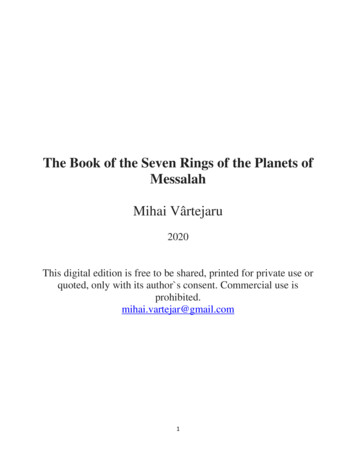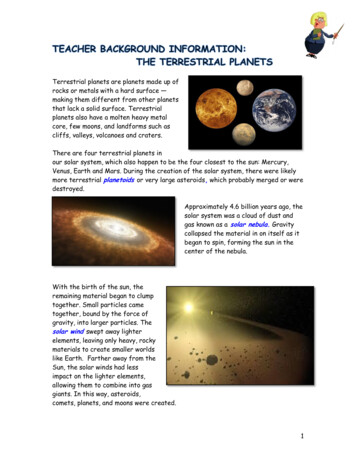
Transcription
Terrestrial planets are planets made up ofrocks or metals with a hard surface —making them different from other planetsthat lack a solid surface. Terrestrialplanets also have a molten heavy metalcore, few moons, and landforms such ascliffs, valleys, volcanoes and craters.There are four terrestrial planets inour solar system, which also happen to be the four closest to the sun: Mercury,Venus, Earth and Mars. During the creation of the solar system, there were likelymore terrestrial planetoids or very large asteroids, which probably merged or weredestroyed.Approximately 4.6 billion years ago, thesolar system was a cloud of dust andgas known as a solar nebula. Gravitycollapsed the material in on itself as itbegan to spin, forming the sun in thecenter of the nebula.With the birth of the sun, theremaining material began to clumptogether. Small particles cametogether, bound by the force ofgravity, into larger particles. Thesolar wind swept away lighterelements, leaving only heavy, rockymaterials to create smaller worldslike Earth. Farther away from theSun, the solar winds had lessimpact on the lighter elements,allowing them to combine into gasgiants. In this way, asteroids,comets, planets, and moons were created.1
Planets like Earth grew from thecollisions of smaller planets, asteroidsand minute particles of rock and dustin a process called accretion. Thesmaller planets, often calledplanetesimals, ranged in size from 10sto 100s of kilometers in diameter.The decay of naturally occurring radioisotopes in theinteriors of the young planets created heating. Insome cases, the heating changed the interior, creatinga layered arrangement of recrystallized rock. Deeperlayers were changed more severely, while shallowerlayers were less affected. The uppermost layer ofrock was often disturbed by collisions of smallasteroids, which created an uneven soil covering overthe surface rock layer.This type of layered interior has beenreconstructed from meteorite fragments thathad fallen to Earth. The debris was created whenplanetesimals collided and were blown apart,exposing the cores of the bodies and ejectingmaterial out into the inner solar system. Some ofthe largest fragments produced the heavilycratered surfaces of the Moon, Mars, and otherplanetary bodies.Analysis of meteorites indicates that sometime between 4.56 and4.44 billion years ago a planetary body approximately the size ofMars hit the Earth. It crashed into Earth with such tremendousforce that enough material was ejected into space to form theMoon. In addition, the impact caused the Earth to take on its 231/2 angle of rotation and heated the remaining Earth to themelting point.It is this final step, the melting of asignificant portion of the Earth’s massduring collision, which was responsible forthe chemical composition, now observedwithin the Earth.2
Initially, the Earth existed as a more-or-less homogeneous mixture of material.However, the melting that accompaniedthe Moon-forming collision resulted inlarge-scale changes in its chemicalstructure. This change, ordifferentiation, occurred thoughchemical segregation based on density.When the early Earth heated, the heavyelement iron (Fe) sank through theabundant lighter elements oxygen (O)and silicon (Si). The metallic core of Earth formed first, and then gathered lighterelements around it to form its crust and mantle. This whole-scale change in theEarth’s chemical organization has had major effects on geologic processes eversince. Earth, like the other terrestrial planets, probably collected the morenebulous pieces that would form its atmosphere.MERCURYMercury is a sunbaked world, with surface temperaturestypically sufficient to cook a turkey and humidity levelsthat make the sub-Saharan desert look excessivelyhumid. This little world is locked in a strangegravitational dance with the Sun, which causes it torotate on its axis only 1.5 times during its brief 88Earth-day year. This means 1 day on Mercury stretchesacross 58.7 Earth days. During its languid rotation, it very precisely keeps its polespointed straight up and down – there is none of the tilt that on Earth provides usout seasons. This means that its poles never face the Sun and within the depths ofits polar craters there are places that only know darkness. In those shadows,Mercury actually has ice. But where the Sun hits there is nothing but bakedmetallic dirt.Mercury is the smallest of the eight planets.Mercury's diameter is 3,030 miles (4,878 km), aboutthe size of the continental United States. Thismakes it about two-fifths the size of Earth. Theplanet has a mean radius of 1,516 miles (2,440 km),and its circumference at the equator is 9,525 miles(15,329 km). Mercury turns very slowly on its axis,with one side constantly facing the nearby Sun. In fact, the planet spins on its axisonce every 58.65 Earth days. Mercury orbits once every 87.97 Earth days, so it3
rotates only three times every two Mercury years.Mercury has a mass of 330 x 1023 kilograms. This mass iscontained in a volume of 14.6 trillion cubic miles (60.8trillion cubic km). The mass and volume of Mercury is onlyabout 0.055 times that of Earth. But because Mercury'ssmall mass is enclosed inside of a tiny body, the planet isthe second densest in the solar system, weighing in at5.427 grams per cubic centimeter, or 98 percent of thedensity of our planet; only Earth is denser.Mercury's surface greatly resemblesthat of Earth's moon, with craters leftover from the heavy bombardment earlyin the life of the solar system andduring the planet's formation. Imagestaken by orbiting spacecraft showcraters ranging from 328 feet (100 m)to 808 miles (1,300 km) across. Theplanet has numerous steep cliffs orslopes created by faults. Some are ashigh as 1.86 miles (3 km).Mercury's small size makes it too weak to hold on to a significant atmosphere,especially with the constant bombardment itreceives from the Sun. The planet has a thinatmosphere, but it is constantly blasted into spaceby the solar wind. Without an atmosphere to helpstabilize the incoming heat from the sun, the planetboasts some of the most changeable temperatureswings in the solar system. Orbiting only a fewmillion miles from the Sun, Mercury is constantlybombarded by solar weather. The fast-moving,constantly blowing solar winds bombard Mercury,sending plasma down to the surface. The makeup ofMercury's atmosphere is shown in the pie graph atthe right.4
Mercury was thought to be unable togenerate a magnetic field because of itssmall size and lack of recent geologicactivity, suggesting a cold interior.Astronomers now believe that Mercury has amagnetosphere similar to the Earth'smagnetic field, but with a strength about 1%that of the Earth's. The observed magneticfield may mean that the core of Mercury isat least partially molten. The hydrogen and helium atoms likely come from the sun,streaming in on the solar wind and spreading out through the planet's atmosphere.Water vapor and other elements were probably transported and left behind byimpacting comets and meteorites. Eventually, these gases are caught by the solarwind and carried off of the planet. With virtually no atmosphere, Mercuryexperiences very little in terms of traditional weather.The lack of atmosphere also contributes to the planet's wildtemperature extremes. On other planets, the atmospherefunctions as a blanket, with the greenhouse effect helping toredistribute heat somewhat. But on Mercury, the thinatmosphere does nothing to stabilize the incoming solarenergy—and because the distance to Mercury from the Sunis so small, the dayside of the planet feels the heat intensely,while the night side, turned from the sun, only registers thecold. The temperature of Mercury varies from day to night, but the planet onlychanges slight during its seasons. The planet stands essentially straight up anddown in relation to its orbit, with no tilt to put one hemisphere closer than theother. Temperatures can reach 800 C in the daytime and plunge to -180 C atnight.VENUSVenus, the second planet from the Sun, and Earth are oftencalled twins because they are similar in size, mass,density, composition and gravity. However, the similaritiesend there. Venus is the hottest world in the solar system,despite the fact that it is not the planet closest to theSun. Temperatures reach 870 degrees Fahrenheit (465 C),more than hot enough to melt lead. Probes that scientistshave landed there have survived only a few hours beforebeing destroyed.5
The surface of Venus is extremely dry. Duringits evolution, ultraviolet rays from the Sunevaporated water quickly, keeping it ina “prolonged molten state” longer that Earth’s.There is no liquid water on its surface todaybecause the scorching heat created by itsozone-filled atmosphere would cause any to boilaway. About two-thirds of the Venusian surfaceis covered by flat, smooth plains that are marredby thousands of volcanoes, some of whichare still active today and six mountainous regions make up about one-third of theVenusian surface.Venus takes 243 Earth days to rotate on its axis, theslowest of any of the major planets. . The north pole ofVenus is "upside down" relative to its orbit. Venus alsohas a very small tilt of only 3.39 degrees with respect tothe sun, compared to 23.4 degrees on Earth. On ourplanet, it is the tilt that provides us with the change inseasons; the hemisphere slanted closer to the sun feelsthe heat of spring and summer. The lack of significant tiltcauses only slight temperature variations from the equator to the poles and meansthat even if Venus got rid of its overheated atmosphere, it would still feel fairlyconsistent temperatures year round.Some planets, like Earth, Mercury, Jupiter and Saturn, have magnetic fieldscreated by their iron core. The magnetic field that protects Earth extends fromthe inner core out to where it meets charged particles coming from the Sun, alsoknown as solar wind. The magnetic field shields the atmosphere from the highenergy particles coming from space. Because of its sluggish spin, Venus’ metal corecannot generate a magnetic field similar to Earth's. As a result, Venus lacks a truemagnetosphere and what it does have is measured at -100,000 when Earth is 1.Thedifferences that have been observed may explain the fact that some gasses andwater were lost from the Venusian atmosphere.Venus has a hellishatmosphere consisting mainly ofcarbon dioxide with clouds of sulfuricacid. Scientists have only detectedtrace amounts of water in theatmosphere. The atmosphere is6
heavier than that of any other planet, creating a surface pressure 90 times that ofEarth. Someone standing on the ground on Venus would experience air about 90times heavier than Earth's atmosphere; pressures are similar to diving 3,000 feetbeneath the ocean.Venus’ distinction of being the hottest planet in the solar system is entirely thefault of its atmosphere, which is made up almost completely of carbon dioxide.Nitrogen exists in small doses, as do clouds of sulfuric acid. The air of Venus is sodense that the small traces of nitrogen are four times the amount found on Earth,although nitrogen makes up more than three-fourths of the terrestrial atmosphere.This composition causes a runaway greenhouseeffect that heats the planet even hotter than thesurface of Mercury. When the rocky core of Venusformed, it captured much of the gasgravitationally. In addition to warming the planet,the heavy clouds shield it, preventing visibleobservations of the surface and protecting it frombombardment by all but the largest meteorites.Although Venus and Earth are similar in size, themost Earth-like atmosphere in the solar systemoccurs 30 to 40 miles (50 to 60 kilometers) abovethe surface of Venus. Both oxygen and hydrogen rise above the heavier gas layercovering the ground, and the pressures are similar to our planet.Venus’ atmosphere acts like a thermal quilt, 93 times denser than Earth's and madeup mostly of carbon dioxide and sulfur dioxide. These conditions make it awfullyhard to hold on to the oceans and seas that served as the incubators for allterrestrial life. If you could collect all of the water on Earth and distribute itevenly around the planet, it would make a global ocean 1.9 miles (3 km) deep. Do thesame with the trace amounts of water in the Venusian atmosphere, and the depthof your ocean would be just 1.8 in. (3 cm).The clouds of Venus appear to be bright whiteor yellow. Unlike Jupiter or Saturn, there are nodiscernable bands or storms visible to the nakedeye. Winds of about 224 mph (360 kph) keepthe clouds of Venus in constant motion. Thoughthe planet spins slowly, the clouds zip around thetop of the planet every four days. But wind7
speeds drop closer to the surface, where they only move a few miles per hour.MARSMars is the fourth planet from the sun. It earned itsnickname of the ‘Red Planet’ from the red dust thatcovers its surface. Back when there was more wateraround on Mars, the iron-rich rocks on the surfaceoxidized (rusted), turning a reddish brown color. Whenthe reddish brown dust gets blown up into theatmosphere, the whole planet takes on a reddish hue.Liquid water currently cannot exist on the Martiansurface for any length of time. This means that althoughthis desert planet is just half the diameter of Earth, ithas the same amount of dry land. Vast deposits of whatappear to be finely layered stacks of water ice and dustextend from the poles to latitudes of about 80 degreesin both hemispheres. On top of many of these layereddeposits in both hemispheres are caps of water ice thatremain frozen all year round. Additional seasonal caps offrost appear in the wintertime. These are made of solid carbon dioxide, also knownas "dry ice," which has condensed from carbon dioxide gas in the atmosphere. Inthe deepest part of the winter, this frost can extend from the poles to latitudes aslow as 45 degrees, or halfway to the equator.Mars is much colder than Earth, in large part due to its greater distance from thesun. The average temperature is about minus 80 Fahrenheit (- 60 C), althoughthey can vary from -195 F ( -125 C) near the poles during the winter to as much as70 F (20 C) at midday near the equator. The carbon-dioxide-rich atmosphere ofMars is also roughly 100 times less dense than Earth's on average, but it isnevertheless thick enough to support weather, clouds and winds. The density of theatmosphere varies seasonally, as winter forces carbon dioxide to freeze out of theMartian air.The axis of Mars, like Earth's, is tilted with relation tothe sun. This means that, the amount of sunlight falling oncertain parts of the planet vary widely during the year,giving Mars seasons.However, the seasons8
that Mars experiences are more extreme than Earth's because its elliptical, ovalshaped orbit around the sun is more elongated than that of any of the other majorplanets. When Mars is closest to the sun, its southern hemisphere is tilted towardthe sun, giving it a short, very hot summer, while the northern hemisphereexperiences a short, cold winter. When Mars is farthest from the sun, the northernhemisphere is tilted toward the sun, giving it a long, mild summer, while thesouthern hemisphere experiences a long, cold winter.Earth's magnetic field isgenerated by an active dynamoa hot core of molten metal. Themagnetic field surrounds Earthand is considered global (imageon left). The various Martianmagnetic fields do notencompass the entire planet andare local (image on right). TheMartian dynamo is extinct, and its magnetic fields are "fossil" remnants of itsancient, global magnetic field. This, however, does not mean that Mars does nothave a magnetosphere; simply that it is less extensive than that of the Earth andprovides no protection from the Sun’s radiation. Any life forms on the surfacewould constantly be bombarded with cosmic rays. In addition, much of the gas lostfrom the Martian atmosphere, was probably stripped away by the solar wind, whichwas able to reach the atmosphere as Mars cooled and lost its magnetic field andprotective magnetosphere. Water was probably lost as well, as the ultraviolet lightbroke apart any water molecules in the atmosphere and the lightweight hydrogenescaped into space.Mars has a thin atmosphere — too thin to easily support life as we know it. TheMartian atmosphere is around 100 times thinner than Earth’s, which means airpressure is significantly less on Mars than on Earth, so there is basically no air tobreathe, and not enough pressure to keep bodily fluids in a normal liquid state. Thegases dissolved in a human’s bloodstream would start to escape— their blood wouldprobably literally boil.Just as much of an issue is the composition of whatlittle atmosphere there is on Mars. The thin Mars airis radically different and basically toxic. Theatmosphere of Mars is about 100 times thinner thanEarth's, and it is 95 percent carbon dioxide.9
Temperatures on Mars are much lower thanEarth’s, not only because it's farther from thesun, but because a thinner atmosphere does notsupport a strong greenhouse effect. Somescientists think that Mars may be the victim of arunaway greenhouse effect in the opposite senseof Venus. As water ice froze the planet becamemore and more reflective and its atmospherethinner and thinner, freezing more and morewater and eventually carbon dioxide as well.Despite the fact that the atmosphere is morethan 95 percent CO2 by volume, almost all of it islocked up in the Martian rocks. Mars does have a greenhouse effect, but it's veryweak because the Martian atmosphere is so thin, and as a result, heat from the Sungoes back into space.Despite its thin atmosphere, Mars still has a weather system. Martian weatherphenomenons are the result of its extreme seasonal changes. Polar temperatures atthe winter pole drop so low (about –130 C) that carbon dioxide condenses into dryice at the polar cap; frozen carbon dioxide at the summer pole sublimates intocarbon dioxide gas. The atmospheric pressure therefore increases at the summerpole and decreases at the winter pole, driving strong pole-to-pole winds. Storms onMars can engulf the entire planet.Giant dust devils routinely kick up theoxidized iron dust that covers Mars'surface. The dust storms of Mars arethe largest in the solar system, capableof blanketing the entire planet andlasting for months. One theory as towhy dust storms can grow so big onMars has to do with heat transfer byconvection. Airborne dust particlesabsorb sunlight and warm the Martianatmosphere in their vicinity. Warm pockets of air flow toward colder regions,generating winds. Strong winds lift more dust off the ground, which in turn heatsthe atmosphere more, raising more wind and kicking up more dust. At times, it evensnows on Mars. Martian snowflakes, made of carbon dioxide rather than water, arethought to be about the size of red blood cells. The north and south polar regionsof Mars are capped by ice, much of it made from carbon dioxide, not water.10
The bulk of Mars’s surface is made of basalticsilicate rock, very similar to the rocks of Earth’soceanic crust. It’s thought that the crust of Mars isjust one piece, so no tectonic plates floating aroundcausing interesting things like subduction zones andearthquakes as found here on Earth. There are somerocks that show striped magnetic reversals, whichindicates that once upon a time Mars had plates thatspread apart like the mid-ocean ridges on Earth dotoday, and a magnetic field that flipped directionsMars does have the largest volcano in the solarsystem, Olympus Mons, which is no longeractive. It is the lack of tectonic activity thathas resulted in Mars’s atmosphere being sothin: it’s thought that carbon dioxide was pulledfrom the atmosphere to make carbonate rocksand without any tectonic processes to recyclethe rocks and de-gas the carbon dioxide intothe atmosphere, it stayed bound up in thecarbonate rocks.There are other rocks and structures onMars that look like they could only haveformed with the presence of water—large amounts of it. There are whatappear to be layered sedimentary rocks(rocks made from grains of sand anddirt, usually laid down underwater thenstuck together to make a rock) andpossibly conglomerates (rocks madefrom pebbles and chunks of other rocksas well as sand and dirt-sized grains all stuck together).Observations of Mars indicate that riversand oceans may have been prominentfeatures in its early history. Billions ofyears ago, Mars was a warm and wet worldthat could have supported microbial life insome regions. But the planet is smallerthan Earth, with less gravity and a thinner11
atmosphere. Over time, as liquid water evaporated, more and more of it escapedinto space, allowing less to fall back to the surface of the planet. Vast deposits ofwater appear to be trapped within the ice caps at the north and south poles of theplanet. Each summer, as temperatures increase, the caps shrink slightly as theircontents skip straight from solid to gas form, but in the winter, coolertemperatures cause them to grow to latitudes as low as 45 degrees, or halfway tothe equator. The caps are an average of 2 miles (3 kilometers) thick and, ifcompletely melted, could cover the Martian surface with about 18 feet (5.6 meters)of water.Frozen water also lies beneath the surface.Scientists discovered a slab of ice as large asCalifornia and Texas combined in the regionbetween the equator and North Pole of the RedPlanet. The presence of subsurface water hadlong been suspected but required theappearance of strange layered craters toconfirm. Other regions of the planet maycontain frozen water, as well. Some high-latitude regions seem to boast patternedground-shapes that may have formed as permafrost in the soil freezes and thawsover time.Riverbeds and gullies indicate that water ran, atleast briefly, across the surface of Mars. Ahundred times more water may have flowedannually through a large channel system known asMarte Vallis than passes through the MississippiRiver each year, according to estimates. Thegullies themselves are smaller, likely formingduring brief torrential rainstorms when fastmoving water could have carved them across theland.On Earth, the land around rivers and lakes iswetter, made up of mud and clays. Such depositsexist on Mars as well, trapping water andindicating where larger bodies may have onceexisted. Organic carbon is seen much more in clayand muds than it is in sandy material. And theSheepbed mudstone (right) already has beenidentified as the remnant of an ancient habitablelake.12
Water may seem like a very common element to those of us on Earth, but it hasgreat value. In addition to understanding how Mars may have changed and developedover time, scientists hope that finding water will help them to find something evenmore valuable — life, either past or present. Only Earth is known to host life, andlife on our planet requires water. Though life could conceivably evolve withoutrelying on this precious liquid, scientists can only work with what they know. Thusthey hope that locating water on celestial bodies such as Mars will lead to findingevidence for life.13
Venus takes 243 Earth days to rotate on its axis, the slowest of any of the major planets. . The north pole of Venus is "upside down" relative to its orbit. Venus also has a very small tilt of only 3.39 degrees with respect to the sun, compared to 23.4 degrees on Earth. On our p

